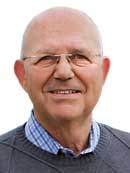Off the Record: Early USGA heroes

Photo: Mike Kenna
As we celebrate the last few months of the USGA Green Section’s 100th anniversary, consider golf’s deep roots in turfgrass science and how the game has played an instrumental role in shaping the academic programs at universities across the country.
Golf unknowingly discovered the complexity of the links ecosystem as the game traveled inland away from the coastline and south toward the tropics. The grasses and management practices that worked in Scotland were not as transportable as the rules, implements and balls used to play the game.
A few individuals interested in the advancement of golf believed it was necessary to reduce the high cost of building and maintaining golf courses. Out of this realization, the Green Section was formed in 1920 to devote itself to these problems.
In the early years, nearly all of the experimental work with turf was carried out at the U.S. Department of Agriculture’s Arlington Farm in Virginia by C.V. Piper, Ph.D., and R.A. Oakley, Ph.D. In a 1925 funding request, titled “Cutting the Cost of Golf,” they emphasized that research should be “carried on in different parts of the country, under varying climatic and soil conditions. Cooperation with the state agricultural experiment stations and with their trained investigators is also most desirable. Expansion of this character is extremely important.”
Through the endeavors of the Green Section to educate and share research results, its pioneer scientists had the full cooperation of some of the country’s best golf course superintendents and green committee members. John Monteith Jr., Ph.D., in a 1932 speech, said, “The immediate result of this educational campaign was to lead greenkeeping out of its dark ages of mysticism and bunkum and give it a modern scientific outlook. This does not mean that all greenkeeping before the advent of the Green Section was shrouded in mysticism and bunkum, neither does it mean that it has performed any miracle such as placing all greenkeeping on a scientific basis.”
The education and research activities were the first to address maintaining a golf course and encouraged an exchange of opinions among early superintendents. The formation of small groups and the organization of what is now the Golf Course Superintendents Association of America (GCSAA) in 1926 all occurred within a short time after the Green Section’s birth. Golf and turfgrass science were beginning to form the bond that still exists today, and there is still sufficient “mysticism and bunkum” for university scientists and superintendents to dispel.
In 1946, Fred Grau, Ph.D., then director of the Green Section, reported in a press release that the Crop Science Division of the American Society of Agronomy was asked to establish a turfgrass section and to appoint a permanent turf committee. Grau said, “It enables scientists to meet on an unbiased common ground for the purpose of integrating their research activities and harmonizing the future development of the national turf program in all its phases.”
For the first time, turf achieved recognition as a critical national entity. Nine years later, turfgrass science had a division of the Crop Science Society of America. The USGA was fortunate to have scientists like Piper, Oakley, Monteith and Grau lead the Green Section, greenkeeping and turfgrass science in those early years. Accomplishments made by scientists during the last 100 years came, in part, due to the early efforts of these and other pioneers, supported by the game of golf.
In the 1931 Golfers Yearbook, Monteith wrote, “Nevertheless, the rapidly accumulating knowledge of turf culture is making it possible for clubs to maintain far better turf today than was possible only a few years ago, and the same marked improvement can reasonably be expected in the future. Progress, however, can only be made in any field in direct proportion to the finding and dissemination of new information, new methods and unfailing interest.”
Golf is needed to help maintain the programs at our universities and agricultural experiment stations. USGA’s Turfgrass and Environmental Research Program (recently renamed the Mike Davis Program for Advancing Golf Course Management) cannot support these institutions alone.









